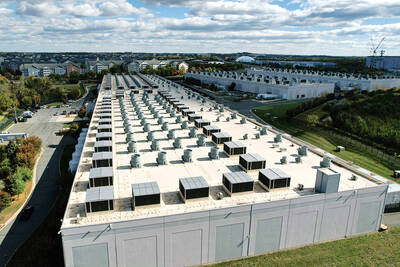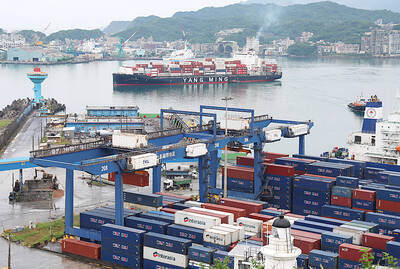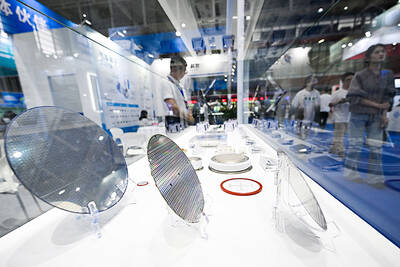The four major subsidiaries of Formosa Plastics Group (FPG, 台塑集團), the nation’s largest industrial conglomerate, yesterday posted combined losses of NT$13.99 billion (US$464.74 million) for last quarter, marking the group’s worst financial performance in five years.
Formosa Petrochemical Corp (台塑石化), the largest of the group’s four listed companies, reported a loss of NT$9.99 billion for last quarter, or losses per share of NT$1.05.
The company blamed plummeting crude oil prices and weakening demand amid the COVID-19 pandemic, as prices of its naphtha and alkene products fell, dealing a heavy blow to its oil refining business.
An inventory loss of NT$5.26 billion also added to last quarter’s poor performance.
Formosa Petrochemical posted revenue of NT$137.53 billion for last quarter, an 8.8 percent decline from NT$150.77 billion in the fourth quarter of last year.
Nan Ya Plastics Corp (南亞塑膠), the nation’s biggest plastics maker, was the only one of the group’s four main units to register a profit last quarter, despite also suffering a downturn in business due to the pandemic.
The company posted a net profit of NT$1.01 billion for last quarter, or earnings per share of NT$0.13, a 75.82 percent decline quarter-on-quarter.
Revenue last quarter contracted 8.5 percent to NT$65.56 billion as the company registered poor sales during and after the Lunar New Year holiday as the coronavirus outbreak started to accelerate.
However, the performance of the company’s electronic components business improved, with the circuit board business turning a profit thanks to growing demand from the deployment of 5G technologies.
Aromatics and styrenics manufacturer Formosa Chemicals and Fibre Corp (台灣化學纖維) posted the group’s second-heaviest loss of NT$4.61 billion, or losses per share of NT$0.79.
Revenue fell 9.8 percent quarter-on-quarter to NT$64.44 billion last quarter.
Formosa Plastics Corp (台灣塑膠) posted a loss of NT$394 million, or losses per share of NT$0.06, while its revenue contracted 13.5 percent quarter-on-quarter to NT$42.02 billion.
The company also blamed the COVID-19 pandemic, which had dragged down demand and prices.

The demise of the coal industry left the US’ Appalachian region in tatters, with lost jobs, spoiled water and countless kilometers of abandoned underground mines. Now entrepreneurs are eyeing the rural region with ambitious visions to rebuild its economy by converting old mines into solar power systems and data centers that could help fuel the increasing power demands of the artificial intelligence (AI) boom. One such project is underway by a non-profit team calling itself Energy DELTA (Discovery, Education, Learning and Technology Accelerator) Lab, which is looking to develop energy sources on about 26,305 hectares of old coal land in

Taiwan’s exports soared 56 percent year-on-year to an all-time high of US$64.05 billion last month, propelled by surging global demand for artificial intelligence (AI), high-performance computing and cloud service infrastructure, the Ministry of Finance said yesterday. Department of Statistics Director-General Beatrice Tsai (蔡美娜) called the figure an unexpected upside surprise, citing a wave of technology orders from overseas customers alongside the usual year-end shopping season for technology products. Growth is likely to remain strong this month, she said, projecting a 40 percent to 45 percent expansion on an annual basis. The outperformance could prompt the Directorate-General of Budget, Accounting and

Netflix on Friday faced fierce criticism over its blockbuster deal to acquire Warner Bros Discovery. The streaming giant is already viewed as a pariah in some Hollywood circles, largely due to its reluctance to release content in theaters and its disruption of traditional industry practices. As Netflix emerged as the likely winning bidder for Warner Bros — the studio behind Casablanca, the Harry Potter movies and Friends — Hollywood’s elite launched an aggressive campaign against the acquisition. Titanic director James Cameron called the buyout a “disaster,” while a group of prominent producers are lobbying US Congress to oppose the deal,

Two Chinese chipmakers are attracting strong retail investor demand, buoyed by industry peer Moore Threads Technology Co’s (摩爾線程) stellar debut. The retail portion of MetaX Integrated Circuits (Shanghai) Co’s (上海沐曦) upcoming initial public offering (IPO) was 2,986 times oversubscribed on Friday, according to a filing. Meanwhile, Beijing Onmicro Electronics Co (北京昂瑞微), which makes radio frequency chips, was 2,899 times oversubscribed on Friday, its filing showed. The bids coincided with Moore Threads’ trading debut, which surged 425 percent on Friday after raising 8 billion yuan (US$1.13 billion) on bets that the company could emerge as a viable local competitor to Nvidia